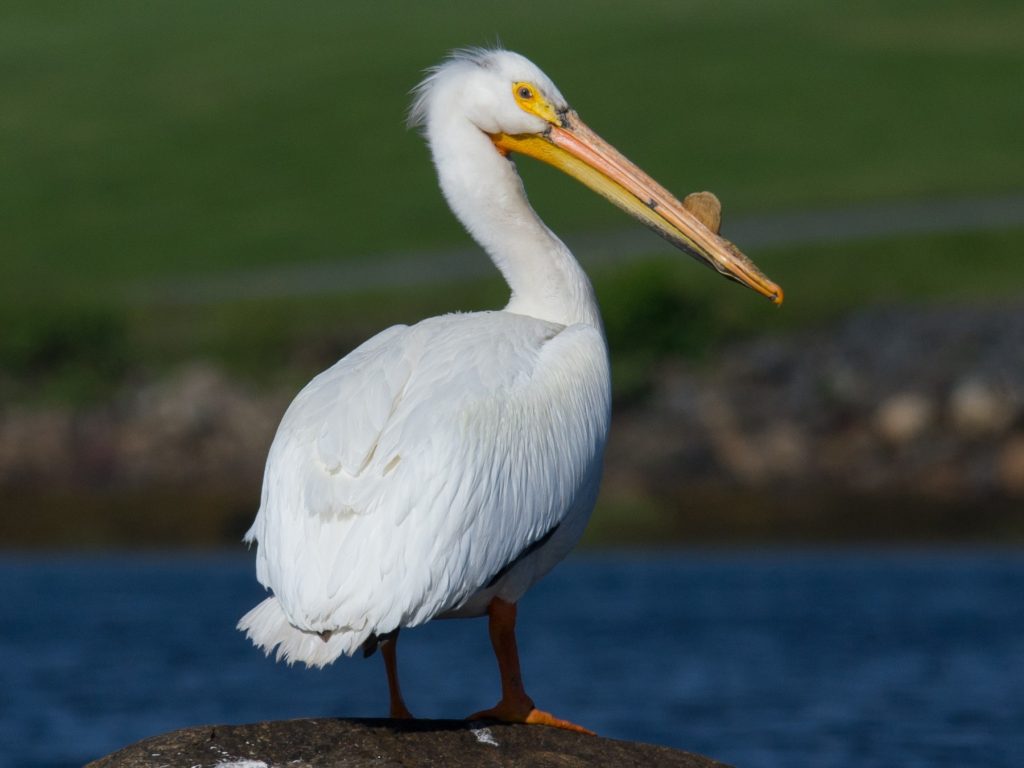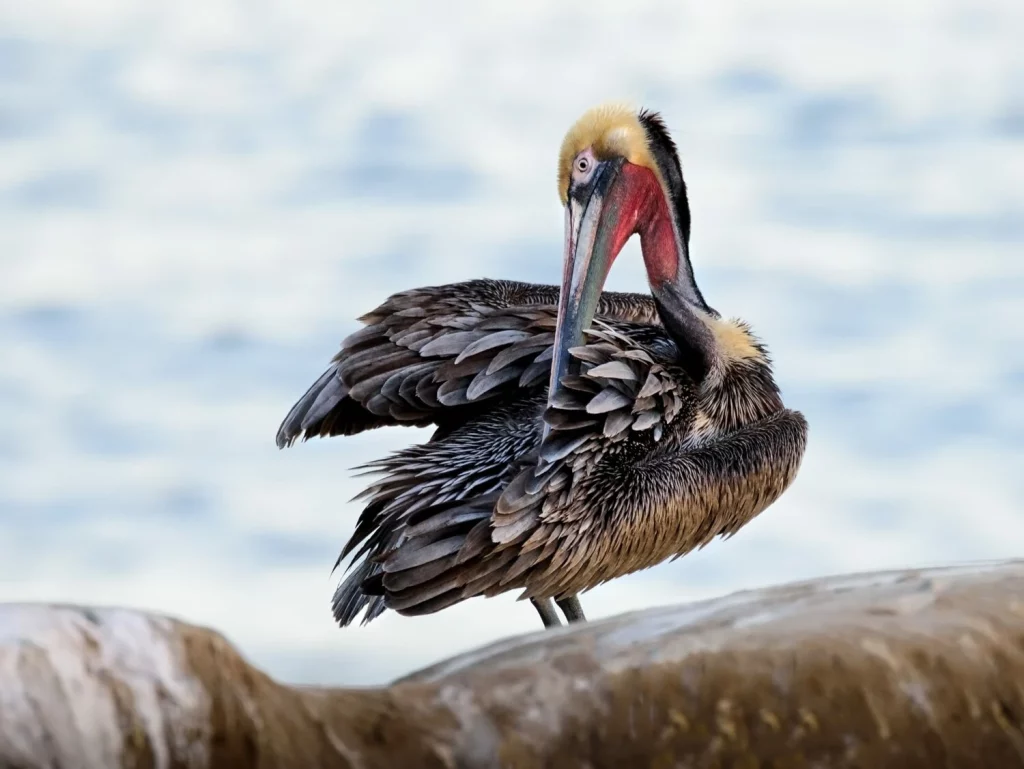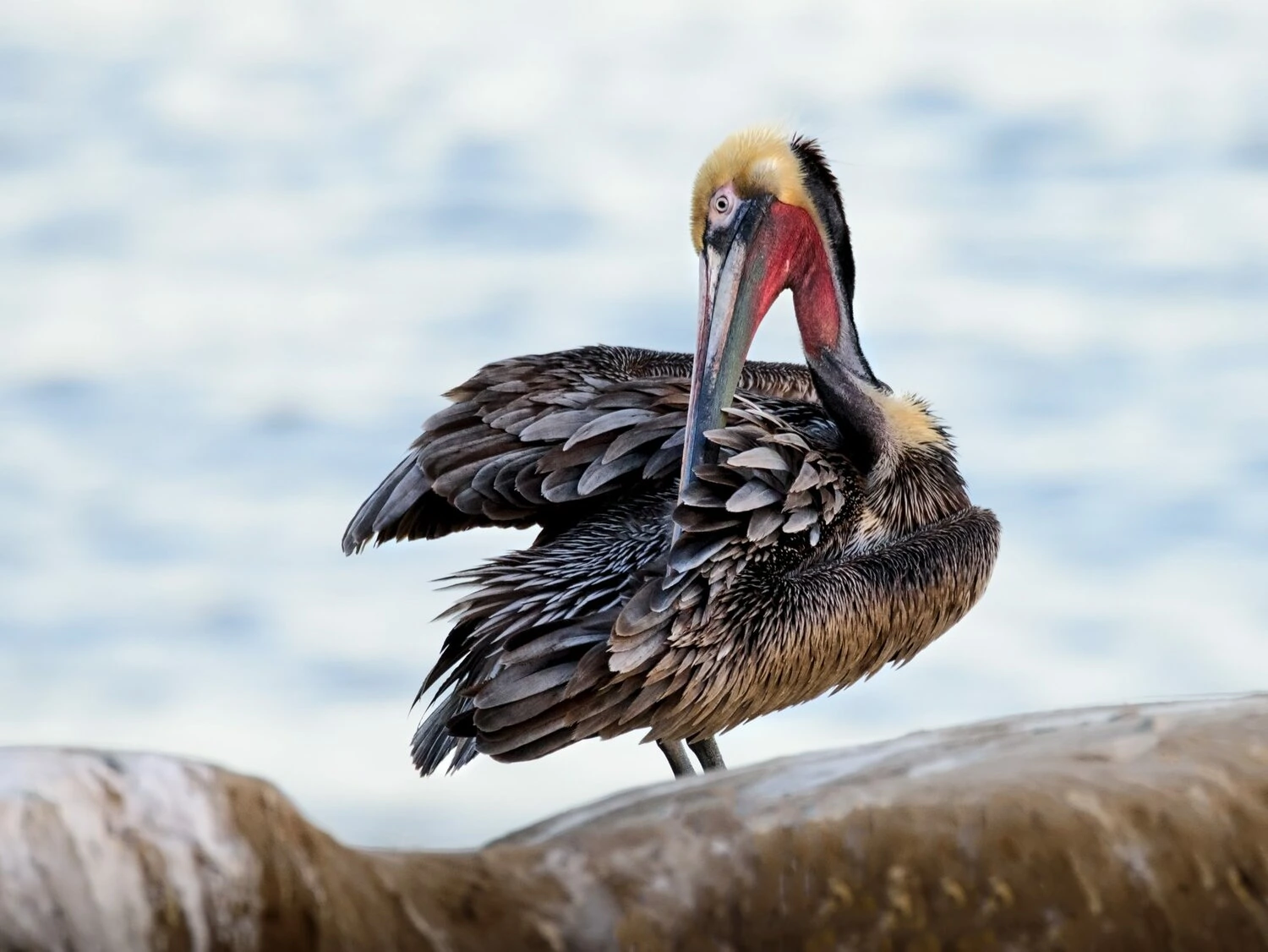In Indiana, you can come across two distinct types of Pelicans among the avian population. These are the American White Pelican and the Brown Pelican.
During the summer season, one can easily spot the American White Pelican in this region. On the other hand, the presence of the Brown Pelican in Indiana is a rarity, making it a seldom sight.
Pelicans, known for their massive bills, expandable throat pouches, and sturdy feet, stand out as one of the largest bird species worldwide. Surprisingly, despite their imposing size, they possess a lightness facilitated by air pockets within their skeletal structure and skin. This buoyancy allows them to float gracefully, while their elongated wings aid in soaring during flight.
Globally, there exist eight distinct species of pelicans, with two of them residing in North America, specifically the American White Pelican and Brown Pelicans.
During the breeding season, the facial skin, throats, and bills of pelicans exhibit vibrant colors and even develop additional appendages on their bills.
Pelicans engage in colony breeding, forming groups of up to 50,000 individuals. Depending on the species, these colonies can either nest on the ground or in trees. After approximately 25 days in the nest, the young ones gather in “creches,” which consist of up to 100 juveniles. Remarkably, the parents can identify their own offspring and solely provide nourishment to them.
Although pelicans are known to prey on various animals, they are not classified as birds of prey, a category reserved for raptors. Their diet primarily comprises fish, yet they also consume crabs, frogs, snakes, mammals, birds, and insects.
To catch fish, pelicans employ their throat pouches, allowing them to capture their prey and drain the water before swallowing. Young pelicans even feed directly from their parents’ pouches.
To assist in identifying the Pelican species frequently sighted in Indiana, this guide draws data from bird enthusiasts on ebird and avibase. It offers factual information regarding the timing of these birds’ appearances.
Indiana’s Pelican Species:
American White Pelican

While some American White Pelicans can be observed throughout the year, their presence becomes more pronounced during the breeding season.
American White Pelicans are majestic birds known for their expansive wingspan, which ranks second highest among all North American avian species.
During the non-breeding period, adult American White Pelicans display a white plumage, with only the black flight feathers becoming visible during flight or when the wings are spread. They possess bluish-gray eyes and yellow facial skin surrounding their eyes. Their bills, pouches, and feet exhibit a pale orange hue. Juveniles, on the other hand, sport light gray feathers accompanied by darker brown napes.
Breeding adult American White Pelicans exhibit distinctive coloration compared to non-breeding adults. They grow a horn-like yellow plate on their upper bills. While their bodies retain the all-white appearance, their eyes, bills, legs, and feet become vividly orange.
American White Pelicans undergo various molting changes, referred to as “eclipse.” In spring, a noticeable yellowish patch appears on their breast and chest, while blackish feathers emerge on their heads during summer.
- Pelecanus erythrorhynchos
- Length: 60 – 63 inches (152 – 160 cm)
- Weight: 246.4 ounces (6983 g)
- Wingspan: 96 – 110 inches (244 – 279 cm)
Breeding in secluded inland lakes across North America, American White Pelicans migrate to the southern Pacific Coast of the United States, the Gulf of Mexico, Mexico, and Central America during winter. Their migration path allows for potential sightings in western and central states of the US.
American White Pelicans can be found in shallow freshwater lakes, wetlands, and along the edges of rivers and lakes. During winter, they frequent coastal bays, inlets, and estuaries, where they forage in shallow waters and rest on sandbars.
Their diet primarily consists of fish, which they capture by swimming near the water’s surface and employing their expansive bills. Pelicans also engage in cooperative foraging, coordinating efforts to corral fish towards the shore for efficient scooping.
These adaptable birds follow food sources over vast distances, exhibiting opportunistic feeding behavior. Additionally, they may consume crayfish, amphibians, salamanders, and are notorious for pilfering fish from other birds while skimming the water’s surface.
American White Pelican vocalizations are generally limited to occasional grunts, with adults remaining mostly silent. However, juvenile pelicans tend to emit noisy calls when begging for food in large colonies.
Nests of American White Pelicans consist of simple, shallow depressions on the ground. Materials such as twigs, sticks, reeds, and other elements are added to the nest for egg protection.
The female lays one to two eggs, both of which are incubated by both parents for approximately thirty-six days. Unfortunately, siblicide, where one sibling kills the other, often results in only one chick surviving in each nest.
Fun Fact: The elongated and capacious bill of the American White Pelican can hold up to three gallons of water. When capturing fish, the pelican tilts its bill downwards to drain the water, allowing it to swallow the remaining catch contained within its throat sac.
Brown Pelican

Brown Pelicans are rarely encountered or considered accidental sightings in Indiana, although a few observations have been made, particularly around Indianapolis. The last confirmed sightings occurred in Hancock in 2021.
During the non-breeding phase, adult Brown Pelicans typically feature white heads and necks, accompanied by pale yellow foreheads. Their lengthy bills showcase a combination of yellow and orange hues. Grayish-brown bodies, short black legs, and webbed feet complete their appearance. Juveniles display brown heads, necks, backs, and wings, while their bills exhibit a bluish-gray shade. Their underparts are light brown.
The Brown Pelican species comprises five subspecies, with two of them breeding within the United States: P.o.californicus along the Pacific Coast and P.o.carolinensis along the Atlantic Coast.
Distinguishing features between Pacific and Atlantic Brown Pelicans become more evident during the breeding season. Both species possess white heads with prominently yellow foreheads. However, the napes of Atlantic Brown Pelicans transition from white to dark brown, while their throat pouches adopt an olive-brown hue. In contrast, Pacific Brown Pelicans exhibit red skin on their throat pouches.
- Pelecanus occidentalis
- Length: 48 – 50 inches (122 – 127 cm)
- Weight: 131.2 ounces (3718 g)
- Wingspan: 78 – 84 inches (198 – 213 cm)
Brown Pelicans either breed, migrate, or remain resident throughout the year along the Pacific and Atlantic coasts of North America, extending to northern South America.
Brown Pelicans can be found in shallow water environments, favoring estuaries, coastal marine habitats, and resting on mangrove islets, sandbars, breakwaters, and offshore rocks.
Their unique foraging ability distinguishes them from other species. Brown Pelicans dive into deep ocean waters to capture prey in their throat pouches. Upon resurfacing, they drain the water, allowing them to swallow their catch immediately.
Their diet predominantly comprises fish, including sardines and herring. When not diving, they casually swim and seize prey using their bills. Additionally, they consume crustaceans such as prawns, amphibians, eggs, and young birds.
Adult Brown Pelicans are generally silent, emitting occasional grunts. Juveniles, however, vocalize loudly when seeking food.
Nests of Brown Pelicans are primarily constructed on the ground, rather than in trees. Islands, mangroves, and cliffs serve as concealed and protected locations. The female builds the nest using reeds, leaves, pebbles, sticks, and soil. She lays two to four eggs, incubated by both parents for approximately one month.
Fun Fact: Brown Pelicans incubate their eggs by covering them with their webbed feet. This practice posed a threat to their survival when the pesticide DDT caused thinning of eggshells, leading to their breakage under the weight of the parents’ feet. Through conservation efforts, the Brown Pelican population was successfully restored.
